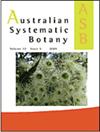Track analysis of the Neotropical species of Capparaceae
IF 1.6
3区 生物学
Q4 EVOLUTIONARY BIOLOGY
引用次数: 2
Abstract
Abstract. The Capparaceae are a family of plants associated mainly with dry areas, which have produced climatic constraints and a limited geographic distribution. This family is considered endemic in the Neotropical seasonally dry forest (NSDF) and, therefore, a model to analyse the NSDF biogeography. We conducted a track analysis of Neotropical species of Capparaceae to identify generalised tracks that recover ancestral biotas of NSDF nuclei, employing 7602 data points for 104 species. Individual tracks were obtained using Prim’s algorithm and generalised tracks were identified using parsimony analysis of endemicity with progressive character elimination. We found six generalised tracks and four panbiogeographic nodes mainly located in the NSDF. Generalised tracks recovered the ancestral biotas of NSDF distributed among the central Andean coast, central inter-Andean valleys (Ecuador), Tarapoto–Quillabamba, Apurimac–Mantaro (Peru) and Piedmont (Bolivia) NSDF nuclei. Also, the pattern of distribution of Capparaceae recovered old connections between northern South America and the inter-Andean valleys. However, we also found generalised tracks located over the Isthmus of Panama and Amazonian–Magdalena valley moist forest, suggesting that the distribution pattern in this family was influenced not only by NSDF climatic constraints, but also by geological events such as the emergence of the Isthmus and Andean uplift.标题红辣椒科新热带种的径迹分析
摘要Capparaceae是一个主要与干旱地区有关的植物科,干旱地区产生了气候限制和有限的地理分布。该科被认为是新热带季节性干燥森林(NSDF)的特有种,因此是分析NSDF生物地理学的模型。我们利用104个物种的7602个数据点,对山柑科新热带物种进行了轨迹分析,以确定恢复NSDF细胞核祖先生物群的通用轨迹。使用Prim算法获得单个轨迹,并使用具有渐进特征消除的地方性的简约分析来识别广义轨迹。我们发现六个广义轨迹和四个泛生物地理节点主要位于NSDF。综合追踪发现了NSDF的祖先生物群,分布在安第斯中部海岸、安第斯山脉间山谷中部(厄瓜多尔)、塔拉波托-奎拉班巴、阿普里马克-曼塔罗(秘鲁)和皮埃蒙特(玻利维亚)NSDF核区。此外,Capparaceae的分布模式恢复了南美洲北部和安第斯山脉之间的古老联系。然而,我们也在巴拿马地峡和亚马逊-马格达莱纳山谷潮湿森林上发现了普遍的踪迹,这表明该家族的分布模式不仅受到NSDF气候限制的影响,还受到地峡和安第斯隆起等地质事件的影响。
本文章由计算机程序翻译,如有差异,请以英文原文为准。
求助全文
约1分钟内获得全文
求助全文
来源期刊

Australian Systematic Botany
生物-进化生物学
CiteScore
3.10
自引率
12.50%
发文量
12
审稿时长
>12 weeks
期刊介绍:
Australian Systematic Botany is an international journal devoted to the systematics, taxonomy, and related aspects of biogeography and evolution of all algae, fungi and plants, including fossils. Descriptive taxonomic papers should normally constitute a comprehensive treatment of a group. Short papers on individual species and nomenclatural papers must contain significant new information of broader interest to be considered. The prestigious L.A.S. Johnson Review Series is published. Other review articles will also be considered. All papers are peer reviewed.
Australian Systematic Botany is published with the endorsement of the Commonwealth Scientific and Industrial Research Organisation (CSIRO) and the Australian Academy of Science.
 求助内容:
求助内容: 应助结果提醒方式:
应助结果提醒方式:


